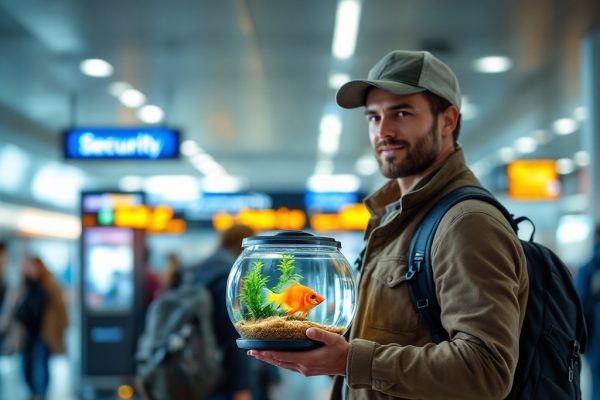Best and Worst Age to Travel with a Baby
Discover the best and worst times to travel with a baby! From the ease of newborn journeys to the challenges of toddler tantrums, this guide reveals the secrets to stress-free family travel. Learn how your baby’s age impacts your trip, from peaceful newborn flights to the adventurous but demanding toddler years. Explore expert tips for managing every stage, ensuring a smoother, more enjoyable vacation for the whole family. Start planning your dream trip today!
Important information

- Newborns (0-3 months) are generally easiest to travel with, as they mostly sleep.
- Babies 3-9 months old travel fairly well due to established routines.
- Consider a separate seat for babies 9-12 months old for comfort and safety, especially using a car seat.
- 12-18 months is often the most challenging age due to increased mobility and potential separation anxiety.
- Traveling with toddlers (1-3 years) presents unique difficulties, requiring careful planning and flexibility.
Best and Worst Ages to Travel with a Baby
Traveling with a baby can be easy or challenging depending on their age. Newborns (0-3 months) often sleep peacefully through journeys. Babies 3-9 months old travel fairly well, with more established routines. Consider purchasing a separate seat for babies 9-12 months old for added comfort and safety. The most challenging travel period is typically between 12 and 18 months, due to increased mobility and separation anxiety. Traveling with toddlers presents its own set of hurdles. Careful planning and considering your child’s developmental stage are essential for a smooth trip.
Newborns (0-3 months): Surprisingly easy travel companions, often sleeping through much of the journey.
Babies 3-9 months old: Travel fairly well, as their routines are more established.
Babies 9-12 months old: Purchasing a separate seat is worth considering for added comfort and safety.
12-18 months: The most challenging period for air travel due to increased mobility and potential separation anxiety.
Toddlers: Traveling with toddlers presents its own unique challenges.
0-3 Months: Ideal for Flying
Traveling with newborns (up to three months old) is often surprisingly easy. They typically sleep for extended periods and don’t require much entertainment, making their needs straightforward, mainly feeding and diaper changes.
3-9 Months: Advantages of Air Travel
Traveling with a baby between 3 and 9 months old can be surprisingly enjoyable. At this age, they are content in a bassinet or your arms, and their lack of mobility simplifies travel significantly. Predictable sleeping and eating routines make planning flights much easier. Plus, they are still light enough to carry comfortably.
9-12 Months: Considerations for Buying a Seat
Between nine and twelve months, babies’ activity levels significantly increase. A separate seat accommodates their need to move and provides added comfort.
Furthermore, a dedicated seat allows for the use of a car seat, greatly enhancing their safety during flights.
12-18 Months: Challenges of Flying
Traveling with toddlers between one and one and a half years old can be challenging. Their mobility and curiosity, combined with easy frustration, make air travel especially tough. At this age, their limited understanding of instructions can be difficult for parents to manage.
Toddlers: The Most Difficult Age for Travel
Traveling with toddlers (ages 1-3) can be challenging. Their limited language skills can make navigating unfamiliar environments difficult. Unpredictable mood swings and tantrums can disrupt travel plans. Their growing independence often clashes with travel restrictions, frustrating both parent and child. Adapting to new routines is also tough for this age group, which adds another layer of complexity to traveling with toddlers.
Benefits of Traveling with Babies
Traveling with babies offers unique perks. Their tendency to eat and sleep for extended periods makes long journeys, like flights, surprisingly manageable. Infants, especially before establishing routines, easily adapt to new environments. Pre-walking babies eliminate the need for airport chases, a definite advantage in bustling terminals and tourist attractions.
These trips create lasting family memories as parents introduce their children to new cultures, enriching their early development and strengthening family bonds.
Babies’ portability simplifies airport navigation, public transport, and on-foot exploration.
Why Babies Are the Best Age for Travel
Traveling with babies can be surprisingly easy. They need less entertainment than toddlers, and before they start moving around, they are much simpler to manage. Since they haven’t yet developed the urge to explore on their own, keeping them safe is less stressful. Plus, their longer sleep schedule gives parents more chances to relax.
Infant Travel Advantages: Eating and Sleeping Patterns
Traveling with a baby can be surprisingly manageable. They often sleep soundly during car rides and flights, which simplifies travel. These frequent naps often coincide with travel schedules. Feeding schedules also integrate easily into your itinerary. So, pack your bags and embrace the adventure.
Traveling Before Babies Start Walking
Traveling with a pre-walking baby can be easier due to their limited mobility. This makes them more manageable on trips, reducing parental stress. However, careful planning is essential. Pack enough diapers and formula. A comfortable carrier is recommended for navigating busy airports and crowded spaces.
Challenges and Tips for Traveling with Toddlers
Traveling with toddlers can be challenging. Their short attention spans, unpredictable tantrums, and constant need for snacks and breaks can disrupt even the best-laid plans. However, with some preparation and a flexible mindset, it can be a rewarding experience.
Maintaining Familiar Routines
Maintaining familiar routines can significantly ease the transition to a new environment. Try sticking to regular nap times and meal schedules, even if it means adjusting your itinerary. Packing familiar comfort items, like favorite toys, books, and snacks, can also provide a sense of security. Choosing child-friendly destinations with age-appropriate activities and accommodations will further enhance the trip.
Planning Your Journey
When planning your journey, consider direct flights to minimize travel time and discomfort. Pack snacks and entertainment to keep your little one occupied. Most importantly, be prepared for the unexpected. Flexibility is essential when traveling with toddlers. Understanding your child’s triggers and developing coping strategies, such as offering a favorite toy or engaging in a calming activity, can help manage tantrums effectively. With a little planning and patience, traveling with your toddler can create lasting memories.
Understanding Toddler Travel Difficulties
Traveling with toddlers can be challenging due to their unpredictable nature, tantrums, and fussiness, which can make long trips particularly difficult. However, a little planning can significantly ease the journey. Packing snacks and toys, along with scheduling regular breaks, can keep toddlers happy and entertained, making the travel experience more manageable. Consider these helpful tips for traveling with toddlers:
- Pack a variety of healthy snacks to satisfy hunger and prevent meltdowns.
- Bring engaging toys and books to keep toddlers entertained during the journey.
- Schedule regular breaks for diaper changes, stretching, and playtime.
Should You Travel with a Tantruming Toddler?
Traveling with toddlers can be challenging. Unexpected tantrums can disrupt even the best plans, making the trip stressful for everyone. By understanding your child’s temperament and anticipating potential issues, you can plan accordingly and minimize travel-related stress. Here’s how:
Pack strategically. Bring familiar toys, books, and snacks to comfort your child during the journey. Don’t forget essentials like diapers, wipes, and any necessary medications.
Maintain routines as much as possible. Sticking to regular nap times and meal schedules can help regulate your toddler’s mood and prevent meltdowns. Consistent routines provide a sense of normalcy in unfamiliar surroundings.
Plan for breaks and downtime. Toddlers have short attention spans and need regular breaks from travel. Factor in stops for playtime and stretching to avoid restlessness and frustration.
Manage expectations. Travel can be tiring and overwhelming for toddlers. Be prepared for some challenging moments and try to remain patient and understanding.
Engage your toddler during the journey. Singing songs, playing games, or reading stories can help keep them entertained and distracted, reducing boredom and restlessness.
Essential Tips for Air Travel with Infants
Consult your pediatrician before your baby’s first flight.
Pack essential items in your carry-on, such as diapers, wipes, formula or breast milk, and a change of clothes.
To ease ear pressure during takeoff and landing, try feeding your baby or offering a pacifier.
A familiar blanket or toy can provide comfort.
A baby carrier can simplify airport navigation.
Pediatrician Advice for Infant Travel
Before flying with your baby, consult your pediatrician. They can discuss necessary vaccinations and address potential health risks specific to your destination. They can also recommend any needed medications and offer helpful tips for managing ear pressure and jet lag. If your baby has any pre-existing medical conditions, discuss these with your pediatrician to ensure safe and healthy travels.
Preparing for Your Baby’s First Flight
Before your baby’s first flight, consult your pediatrician. Pack essential items, like diapers, wipes, formula or breast milk, and any necessary medications. A familiar toy or blanket can provide comfort. Booking a flight during your baby’s typical nap time can make the trip smoother. To ease ear pressure during takeoff and landing, try nursing or offering a pacifier. A bulkhead seat offers extra legroom, but these seats are often booked quickly. Finally, be prepared for potential delays, prioritizing your baby’s comfort above all.
Consult your pediatrician before your baby’s first flight.
Pack essential items like diapers, wipes, formula or breast milk, and any necessary medications.
Bring a familiar toy or blanket to provide comfort.
Book a flight during your baby’s typical nap time for a smoother trip.
To ease ear pressure during takeoff and landing, try nursing or offering a pacifier.
Consider booking a bulkhead seat for extra legroom, but be aware that these are often booked quickly.
Be prepared for potential delays, prioritizing your baby’s comfort above all.
Nursing and Feeding Babies During Flights
To ease your baby’s ear pressure during takeoff and landing, try nursing or offering a pacifier. Plan feeding times around the flight schedule, and pack ample formula, breast milk, or baby food. Pack extra supplies to account for potential delays. This will ensure you’re prepared for unexpected circumstances like a flight delay.
Reducing Baby’s Ear Pressure and Flight Anxiety
Nursing or offering a pacifier can help equalize your baby’s ear pressure during takeoff and landing. Familiar comforts, like a favorite blanket or toy, can soothe your baby and reduce anxiety. Bulkhead seats offer additional space and comfort.
Flight Attendants’ Tips for a Smooth Experience
Desire additional legroom? Secure a bulkhead seat.
Flight attendants offer more than just drinks. They can warm baby bottles, provide extra blankets, and even find a bassinet for your baby. For special needs, inform them early in the flight. Don’t hesitate to ask; they are happy to help.
Health Considerations for Traveling with a Baby
Before your trip, consult your pediatrician. They can give necessary immunizations and advice on precautions and vaccinations specific to your destination. A pre-trip checkup can also identify potential health issues.
To maintain your baby’s sleep routine during travel, pack familiar items like a favorite blanket or toy. A portable white noise machine or app can be helpful. Plan travel around nap times. Frequent breaks during car trips and flights booked around their sleep schedule can also help.
Baby Immunizations and Health Checks
Before traveling with your baby, consult your pediatrician to ensure their vaccinations are up-to-date and discuss any travel health concerns during a check-up.
Managing Baby Sleep Patterns and Nap Time Travel
Traveling with a baby can be a smooth experience with a little planning. Structure your itinerary around their sleep schedule and maintain their usual bedtime routine. Familiar comforts like a favorite blanket or white noise machine can provide a sense of security in new environments. Factor in nap times when planning activities. If traveling across time zones, gradually adjust their sleep schedule in the days before departure to ease the transition.
Travel Logistics and Essentials for Parents
Traveling with a baby can be a breeze with the right preparation. Pack a safe and comfortable carrier for hands-free movement and a well-stocked diaper bag with essentials like diapers, wipes, and changing pads. Dress your baby in climate-appropriate clothing and bring familiar toys, books, and a portable sound machine for comfort. Don’t forget snacks, formula or breast milk, and feeding supplies. Pack burp cloths, bibs, and hand sanitizer for hygiene. A baby first-aid kit is essential for minor emergencies. A foldable stroller can be invaluable for navigating airports, while noise-canceling headphones can help create a calmer travel experience. Here’s a checklist to help you prepare:
- Carrier: choose a safe and comfortable carrier for hands-free movement.
- Diaper bag essentials: diapers, wipes, changing pads.
- Clothing: dress your baby in climate-appropriate clothing.
- Comfort items: familiar toys, books, portable sound machine.
- Feeding supplies: snacks, formula or breast milk, feeding supplies.
- Hygiene items: burp cloths, bibs, hand sanitizer.
- First-aid kit: a baby first-aid kit is essential for minor emergencies.
- Foldable stroller: invaluable for navigating airports.
- Noise-canceling headphones: can help create a calmer travel experience.
Must-Have Baby Travel Essentials
Packing for your baby’s outing requires careful consideration of essential items. For diaper changes, pack diapers, wipes, a changing pad, and diaper rash cream. Feeding necessities include formula or breast milk, bottles, and a nursing cover if you are breastfeeding. Comfort items, such as a pacifier, favorite toy, and a familiar blanket, can help soothe your baby. Pack extra clothes for unexpected messes. A first-aid kit with infant pain reliever, a thermometer, and any prescribed medications is crucial. For convenient transport, consider a baby carrier or sling. A portable sound machine or white noise app can encourage restful sleep.
Baby Carrier and Diaper Bag Essentials
Traveling with your baby can be a smooth and enjoyable experience with a little preparation. A supportive carrier that protects their head and neck is essential for comfortable travel. Pack a well-stocked diaper bag with essentials like diapers, wipes, a changing pad, rash cream, and disposable bags. For feeding, ensure you have formula or breast milk, along with bottles. A nursing cover offers added privacy if you’re breastfeeding. Pack a change of clothes for both you and your baby. Don’t forget burp cloths. Pacifiers and teething toys can do wonders to soothe a fussy baby. Hand sanitizer is crucial for maintaining hygiene, while sunscreen protects their delicate skin. A small first-aid kit containing pain reliever and a thermometer can provide peace of mind. Consider bringing along some of your baby’s favorite toys or books for entertainment.
Snacks, Distractions, and Noise Cancelling Headphones
Traveling with a baby can be challenging, but with a little preparation, you can ensure a smoother and more enjoyable flight for both of you. Here are some essential tips for keeping your little one happy and comfortable in the air:
Entertainment
Pack engaging toys, books, and comforting items to keep your baby entertained during the flight. Consider bringing new toys that will pique their curiosity and hold their attention longer.
Snacks
Snacks, such as puffs or teething crackers, can help soothe your baby and keep them occupied. Be mindful of any allergy restrictions and choose snacks that are easy to handle and won’t create a mess.
Noise Reduction
Noise-canceling headphones are a lifesaver for reducing the roar of the engine and creating a more peaceful environment for your baby. This can help them relax, sleep better, and minimize discomfort during the flight.
Comfort Items
Bring along familiar comfort items, such as a favorite blanket, pacifier, or stuffed animal. These items can provide a sense of security and help soothe your baby in an unfamiliar environment.














